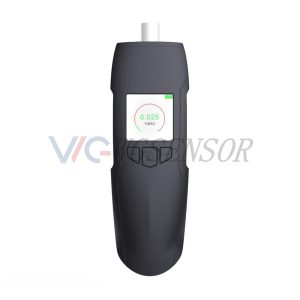Alcohol detectors, commonly known as breathalyzers or alcohol breath testers, are devices designed to measure the concentration of alcohol in a person’s breath. These devices serve a critical role in promoting safety on roads, in workplaces, and various other settings where alcohol consumption can pose risks.
Functionality:
Alcohol detectors operate based on the principle of measuring the amount of alcohol present in exhaled breath. When a person consumes alcohol, it gets absorbed into the bloodstream. As blood circulates through the lungs, alcohol molecules pass through the membranes of the air sacs and into the airways. When the individual breathes out, these alcohol molecules are released in their breath.
The alcohol detector uses a technology known as breath analysis or breathalyzer technology to measure the concentration of alcohol in the breath. This is typically done by utilizing a semiconductor sensor or an infrared spectrometer. The device analyzes the breath sample and provides a reading indicating the Blood Alcohol Concentration (BAC) level.
Types of Alcohol Detectors:
1. Fuel Cell Sensor: This type of sensor uses an electrochemical reaction to measure alcohol concentration. It’s highly accurate and often found in professional-grade devices used by law enforcement.
2. Semiconductor Sensor: These sensors detect alcohol by measuring the change in electrical conductivity caused by alcohol molecules. They are commonly used in personal, handheld devices and are more affordable but may be slightly less accurate than fuel cell sensors.
3. Infrared Spectrometer: Employing infrared light, this type of detector detects specific wavelengths of light absorbed by alcohol molecules. These are highly accurate but tend to be more expensive and are often used in professional settings.
Importance:
Alcohol detectors play a crucial role in various contexts:
1. Road Safety: Law enforcement agencies use these devices to test drivers for alcohol impairment. High BAC levels can indicate intoxication, helping authorities prevent drunk driving accidents.
2. Workplace Safety: In industries where impairment poses risks, such as construction or manufacturing, alcohol detectors are used to ensure employees are not under the influence while working.
3. Personal Use: Some individuals use personal breathalyzers to monitor their BAC levels before driving or operating machinery, promoting self-awareness and responsible behavior.
Limitations:
While alcohol detectors are valuable tools, they have limitations. Factors like mouth alcohol, environmental contaminants, and calibration issues can affect accuracy. Moreover, breathalyzers provide estimates of BAC and may not always reflect precise blood alcohol levels.
Conclusion:
Alcohol detectors are essential devices in maintaining safety and preventing accidents caused by alcohol impairment. While they have their limitations, advancements in technology continue to improve their accuracy and reliability, contributing significantly to public safety efforts.
Always remember, responsible drinking and avoiding any form of impaired driving or operation of machinery remain crucial for personal and public safety.


Please contact us for free quotation by form below. We promise the quickest response within 24 hours: